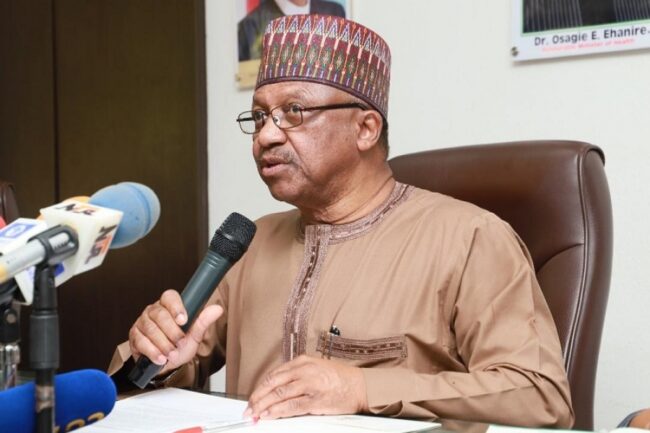For the millions of individuals who have limited or no access to prevention, treatment, and care for neglected tropical diseases, the federal government has stated that it has prepared a multi-sectoral approach (NTDs)
The World Health Organization (WHO) proposed ambitious targets and the innovative approaches to tackle NTDs and provide a blueprint and direction for global elimination. According to the Minister of Health, Dr. Osagie Ehanire, this would be accomplished in the rollout of the 10-year NTDs road map (2021 to 2030).
“The plan is an integrated approach to deliver programs, with emphasis on three approaches,” Ehanire said. “These approaches include moving from process to impact measuring for accountability; putting in place an effective multi-sectoral approach and integration of NTDs; and country ownership and political commitment for sustainability.”
As he exhorted stakeholders to adopt the document as a framework for achieving Nigeria’s goals, Ehanire also revealed that the country had reviewed its NTD Masterplan 2023 to 2027, which was launched today.
As evidence of our group’s commitment to partnership for ownership of the strategic plan, as in the WHO road map, Nigeria supports efforts to involve other disease endemic nations, partners, and stakeholders in the drafting of the “Kigali Declaration on NTDs.”
Onchocerciasis transmission was eradicated in Plateau and Nasarawa States in 2019, and Kaduna, Kebbi, and Zamfara States are expected to follow suit soon, leaving Nigeria with fewer endemic states and more than 28 million people no longer requiring treatment, according to Ehanire. These achievements show that significant progress has been made over the past ten years.
“Among the ministry’s other accomplishments is the epidemiological mapping of NTDs that are avoidable in each of the 774 LGAs. Ongoing Mass Drug Administration in Community and School Deworming Programs
“Mass Drug Administration for Lymphatic Filariasis, Schistosomiasis. 106 of 126 Trachoma endemic LGAs concluding treatment and exceeding elimination threshold, with 30,000,000 persons, who were at risk of going blind from trachoma, reducing their risk to around 3.5,000,000.”
“Of the 200,000 people waiting for trachoma procedures, the NTD Program has taken care of 70% of them. In addition to purchasing anti-snake venom (ASV) and anti-rabies vaccines, national policy and training manuals on snakebite management were also prepared and disseminated to authorized health facilities in all six geopolitical zones.
“Over 40 cases of yaws were discovered in 3 communities in the Plateau and Nasarawa States following a case search. Additional case searches are being conducted in the states of Borno, Bauchi, Kebbi, and Taraba.
The NTD program is currently transitioning from a paper-based data management system to an electronic reporting system using DHIS, and officers are being trained on the use of LMIS tool to monitor drug distribution, consumption, and report the adverse effect of those drugs in accordance with NAFDAC policy on pharmacovigilance.
Strong cooperation is needed to solve sanitation and hygiene challenges, with a focus on policies that will put a stop to open defecation.
The Minister also stated that the gap analysis to strengthen WASH and NTD efforts to date is ready for desk review with existing research, campaigns, and WASH and NTD national and sub-national plans.
Despite some minor successes, NTDs have received little to no attention in the execution of strategies to fight poverty and enhance the wellbeing of patients.
All hands must be on deck to achieve the control and eradication of neglected tropical diseases (NTDs) in Nigeria, which will considerably aid in achieving the Sustainable Development Goals (SDGs). Added he.
Similarly, Joseph Ekumankama, the minister of state for health, stated that the government’s efforts to combat these diseases have begun to show results as the prevalence of these diseases is sharply declining in several states.
Ekumankama expressed optimism that the nation would soon achieve the worldwide goal of eliminating some of these diseases before the end of 2030 given the rate at which the government is combating them.
He emphasized that the NTDs program required effective sector coordination and good creative practices, particularly in areas of Water, Sanitation, and Hygiene (WASH) practices, while the case management component of NTDs needed to be effectively supported for implementation at all levels.
Additionally, 200 LGAs out of 583 endemic LGAs were assessed for lymphatic filariasis in 2022, according to Dr. Aliyu Suleiman, National Professional Officer, NTD, World Health Organization (WHO).
Currently, he noted, “we have less than 300 LGAs that need examination before we halt bulk drug administration for this condition.”
According to Suleiman, the health organization is pushing for the NTD stakeholders and the nation to invest sustainably in NTDs for the best returns, increase NTD integration, cross-sector cooperation, and mainstreaming, and keep NTD services accessible through innovation.
We ask that the nation maintain its commitment to implementing the NTD Road Map 2021-2030, particularly with the introduction of the 2023-2027 master plan, solve funding and medication shortages, and promote partnerships.



